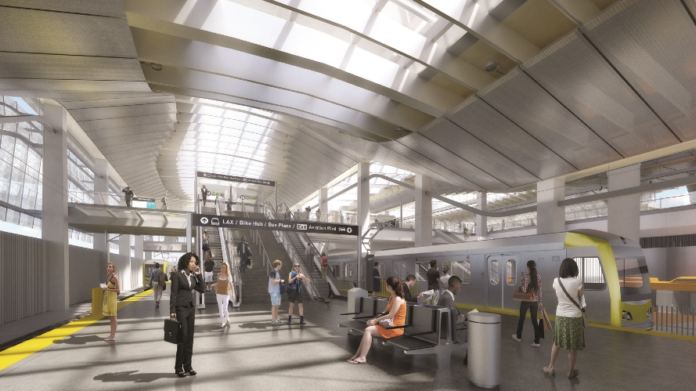The $2.1 billion Metro Crenshaw-LAX rail line and the $1.8 billion downtown Metro Regional Connector project are both slated to open in the second half of 2022. Both projects are running more than two years behind their original scheduled completion dates. But when they finally do open, each is likely to transform both the passenger rail experience and the neighborhoods they traverse.
The 8.5-mile Metro Crenshaw-LAX line will run from the existing E (Expo) Line station at Crenshaw Boulevard through the through the Baldwin Hills, Crenshaw, Leimart Park and Hyde Park neighborhoods, then through Inglewood and on to a close approach to Los Angeles International Airport. There, just east of LAX, it will connect with the $2 billion Automated People Mover project now under construction and set to open in late 2023. The point where they meet is now the site of construction of a $900 million intermodal station known as the Airport Metro Connector, slated for completion in 2024.
When all three projects are complete, the long-awaited rail link to LAX, more than 30 years in the making, will finally be operational.
“The rail extension into the airport makes LAX a more attractive place to come for both business travel and vacationers, which in turn brings in more business to Los Angeles,” said Jerry Nickelsburg, director and senior economist with the UCLA Anderson Forecast.
The 2.1-mile downtown Metro Regional Connector subway project will serve a dual purpose when it is set to open late next year. First, it will make transit travel across the entire Los Angeles County area easier by allowing passengers to go between Azusa and Long Beach and between East Los Angeles and Santa Monica without transferring lines. Then, with new stations atop Bunker Hill, on Historic Broadway and in Little Tokyo/Arts District, it should also bring more business to the cultural and shopping attractions in downtown.
Meanwhile, throughout 2022, construction work will be continuing at and around LAX, the single largest infrastructure project site in Los Angeles history. On the aforementioned people mover, the track supports and station construction will continue. Next year should also see the completion of three terminal extension structures — known as vertical cores — that will connect to the people mover stations, according to Los Angeles World Airports spokeswoman Stephanie Sampson.
One core is between the Tom Bradley International Terminal, another between Terminals 4 and 5, and the third core is between Terminals 5 and 6. Several pedestrian bridges to connect between the people mover stations and the terminals should also be completed next year, she said.
While rail and LAX work may grab the headlines, next year should also see the completion of some road and bridge projects. According to the Los Angeles/Ventura County district office of the California Department of Transportation, two major portions of the massive multidecade effort to widen Interstate 5 should wrap up next year: the $631 million I-5 Valley View Interchange Project in southeastern L.A. County and the $355 million I-5 Empire project in Burbank. Both projects include the addition of carpool lanes along with numerous other improvements.
And a major bridge project is scheduled to wrap up next year: the Sixth Street Viaduct replacement bridge connecting downtown with Boyle Heights. That project is being overseen by the Los Angeles city Bureau of Engineering.
The completion dates for all these projects are somewhat vague — and that’s for a reason, according to UCLA Anderson’s Nickelsburg.
“Getting enough skilled workers for civil construction projects like these is very challenging right now,” Nickelsburg said. “We’re at 900,000-plus payroll jobs in construction statewide right now — which is a record high — and I’m hearing anecdotally of worker shortages on civil construction projects.”
Add in materials shortages caused by the ongoing supply chain issues, and that could spell more delays on infrastructure projects up and down the state.
On the plus side, Nickelsburg said, the region should start seeing the first influx of dollars next year from the massive $1 trillion infrastructure spending bill passed by Congress and signed into law last month by President Joe Biden.

